by Heather Kent | Dec 9, 2022
 While the holiday season can be a wonderful time, it can also be busy and stressful. We have several tools and ideas to help you be stress-free this year so you can fully enjoy your time with family and friends. Below are quick links to some of our most read and rated articles. Hopefully one or two of these will be just what you need this time of year!
While the holiday season can be a wonderful time, it can also be busy and stressful. We have several tools and ideas to help you be stress-free this year so you can fully enjoy your time with family and friends. Below are quick links to some of our most read and rated articles. Hopefully one or two of these will be just what you need this time of year!
Holiday Savings
- Managing the Holidays without Breaking the Bank– this article includes five practical strategies, and even includes step-by-step directions for some homemade gifts.
- Christmas Memories Gifts in a Jar– Make memories with your kids or grandkids (and save some money) by crafting gifts in a jar. This article includes some creative ideas and step-by-step instructions
Holiday Health (Physical & Mental)
- Three ways to Incorporate Mindfulness During the Holidays– this article shares three steps to using mindfulness as a way to mitigate the stress of the season.
- Handling the Holiday Blues– The holidays can be hard- especially if you are experiencing loss. If you or a loved one has the Holiday Blues, this article has eight helpful tips to make this time a little bit easier.
- Healthy Holiday Meals– This article includes ideas for making your favorite holiday dishes a little healthier.
Holiday Fun
- Including Youth in Holiday Traditions– some great ideas for sharing your favorite holiday traditions with youth (or creating new ones)
- Pin a Holiday Memory with Homemade Magnets– this article gives step-by-step instructions on creating magnets to represent your favorite holiday memories (past and present).
by Heather Kent | Oct 4, 2022

Jessica Wells, 4-H alumna and digital media coordinator for Florida Farm Bureau
The statewide goal of the Florida 4-H Program is to “prepare youth to become responsible citizens and productive members of the workforce.” This is accomplished by providing quality youth programs, opportunities for youth to explore their sparks, and connection between youth, adults, or peers that positively shapes a young person’s identity and encourages a growth mindset. Jessica Wells shares her 4-H story and how 4-H helped prepare her for her current job.
Jessica was a 4-H member in Washington County for eleven years. During that time, she participated in several different aspects of the 4-H program, beginning with her 4-H club. 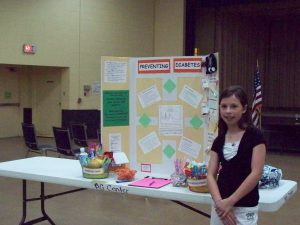
“My favorite 4-H project was the horse project. I was able to grow in my riding abilities and see my horse grow through the year. We were able to accomplish competing at the District level, but most importantly my horse and I were able to share a closer bond because of the time I spent working with him.”
However, Jessica’s involvement with 4-H didn’t stop with her horse club. Jessica was involved in nearly every aspect of the 4-H program. Jessica served as an advocate for her county program, and also served on the planning committee for the Northwest Teen Retreat at the district level. One of her favorite “beyond county” experiences was serving as a Florida 4-H State Executive Board Member.
“It was rewarding in every aspect. I grew so much more, I believe, because I was working with fellow 4-Her’s across the state to bring an amazing experience of state events to all 4-Her’s. Executive Board gave me more than fun memories and life experience, it gave me real, lifelong friendships.”
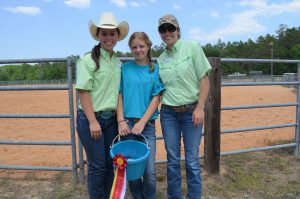
Jessica with one of her club members at a 4-H Horse Show
After graduation, Jessica decided to give back to the 4-H program as a club leader, and during her college years, she also worked for UF/IFAS Extension on campus in Gainesville.
“I was inspired to be a club leader because I wanted to share my passion for horses to youth in my county. 4-H is a wonderful organization that allows one to grow so many personal and lifelong skills while being hands-on with applicable activities. I wanted to use my passion to equip 4-Her’s to grow in their knowledge of horses while growing their public speaking, leadership, teamwork, personal confidence, and many other life skills.”
Today, Jessica serves as the digital media coordinator for Florida Farm Bureau. She credits 4-H with helping her prepare for this role. As a youth, volunteer, and former employee, she had opportunities to learn about leading teams, communication, planning events, and goal setting.
“I am so grateful for all the skills I was prepared with as a 4-Her that has carried into my current position at Florida Farm Bureau. Aside from the general office skills that often
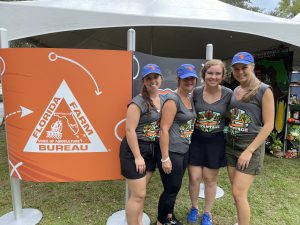
Jessica at a Florida Farm Bureau event
come to mind first, I daily use the management and administrative skills that I learned through 4-H. Through being organized in my projects, leading clubs, planning events, even events as large as horse shows, these different types of management skills prepared me for the daily tasks of a full time job. Like the meeting agenda I would create as a club officer, my current job requires creating simple meeting agendas to keep my co-workers and I on task. Something that small created a big foundation that I can do my job well on. And then on to preparing and leading workshops for my coworkers and other public audiences, again a skill I learned way back in 4-H. Having strong communication skills is vital in today’s work environment, maybe now more than ever. One can be great at the job they were hired for, but if they have great communication skills, it allows them to be even more valuable to their team. An individual does not acquire there skills overnight to use daily in the adult world, these skills are gained over a period of time and usually are rooted in their youth. I was able to gain these skills in my youth through this great organization of 4-H.
by Heather Kent | Sep 21, 2022
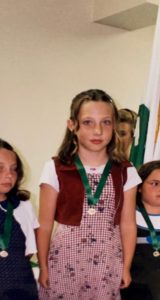
Sara as a young lady received a medal for her 4-H project.
In honor of National 4-H Week, we are sharing the stories of some of our alumni in the Florida Panhandle. Today, we highlight an alumna from Wakulla County! Sara Hillier grew up in Wakulla County, FL, and was active in the 4-H Program. She participated in the local Horse Club, as well as several other county 4-H programs. Sara enjoyed taking canoe trips to learn about natural resources in Wakulla County, and working with others to protect nature by picking up litter. Her favorite 4-H memory was attending summer camp at 4-H Camp Cherry Lake in Madison, FL. She remembers spending the week there with many of her friends and all nine of her first cousins. As a teenager, Sara served as a camp counselor at Cherry Lake.
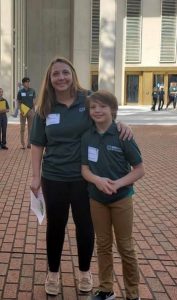
Sara is chaperoning 4-H Day at the Capitol
Sara knew that as soon as her own children were old enough, she wanted them to have many of these same experiences, so she enrolled all three of them in 4-H. Recently, Sara decided she wanted to pay it forward to the program she is so fond of, and made the switch from 4-H mom to 4-H volunteer. Today, Sara leads the Wakulla County Outdoor Adventures Club so she can share her spark for the great outdoors with the next generation. If you have knowledge, skills, or expertise, please consider sharing them through 4-H. We offer flexible opportunities to share your passion with today’s youth. If you are not familiar with 4-H, check out our 4-H Volunteer Welcome Packet for answers to frequently asked questions about becoming a volunteer and schedule a meeting with your local UF/IFAS 4-H Agent.

Today Sara is paying it forward by leading a 4-H Outdoor Adventure Club
by Heather Kent | Sep 21, 2022

Cole as a sophomore at Jacksonville University, a member of the varsity shotgun team.
4-H allows young people to explore their sparks for learning. And through the process, young people learn valuable life skills that prepare them for work and/or college. But many people do not realize that 4-H can help young people secure cash for college or trade school! But college scholarships weren’t on Cole Dillard’s mind when he attended his first 4-H Shooting Sports club meeting. He just wanted to shoot skeet and become a better marksman. Cole joined the Sure Shots 4-H Club in Washington County when he was 10 years old and never looked back. Over the next eight years, he competed in 4-H and other shotgun competitions. He worked hard with his coaches to hone his skills and confidence. He also helped coach younger youth and served as the club president for two years. As a senior 4-Her, he was the Shotgun Individual HOA in 2020 at the Florida 4-H State Match. This earned him a spot to compete at the National 4-H Shooting Sports Match.
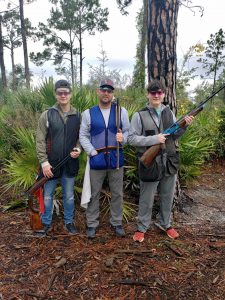
Cole with his brother Cass, and one of his 4-H Shotgun coaches
All that paid off when one of Cole’s coaches introduced him to the Jacksonville University advisor for the varsity shotgun team. After meeting the coach, touring the campus, and shooting with the other varsity members, Cole was offered a varsity scholarship to Jacksonville University as a member of their shotgun team. Today, Cole is finishing his sophomore year and majoring in aviation. His favorite clay target game is skeet, and he was recently named the Jacksonville University “Shooter of the Week.” You never know where exploring your 4-H sparks will take you in life- for Cole, it helped him turn his spark for shooting sports into cash for college!
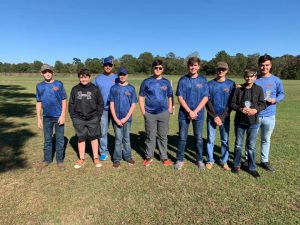
Cole with members of his 4-H Shotgun team, preparing for the state match in 2019
Cole’s story would not have been possible without the caring volunteers who coached him in 4-H Shooting Sports. They shared their passion for the sport so that he could explore his spark, which eventually led to his college scholarship. This is one example of the many ways our 4-H volunteers make a significant difference in the lives of young people. If you have knowledge, skills, or expertise, please consider sharing them through 4-H. We offer flexible opportunities to share your passion with today’s youth. If you are not familiar with 4-H, check out our 4-H Volunteer Welcome Packet for answers to frequently asked questions about becoming a volunteer and schedule a meeting with your local UF/IFAS 4-H Agent.
by Heather Kent | Sep 21, 2022
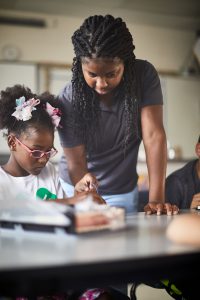
Photo By National 4-H Council
Positive youth development is an intentional process that promotes positive outcomes for youth by providing opportunities that build on young people’s strengths and fostering positive relationships with peers and caring adults (Youth.Gov, 2020). 4-H uses many different strategies to promote the healthy development of youth; but how do we know if positive youth development is really happening in our clubs and programs? One way to be confident that your club is nurturing opportunities for positive youth development is to look for signs that positive youth development is taking place. In the business and education realms, this is known as “continuous improvement.” Continuous improvement is using information (such as data, observation, or self-reflection) to improve the efficiency and effectiveness of an educational program or initiative (Clark et al., 2013). 4-H has been doing continuous improvement from the very start, when the 4-H Motto “make the best better” was adopted in 1920 (4-H History Preservation Program, 2010). Evaluating the 4-H program is a shared responsibility between faculty and staff and volunteers and helps us demonstrate the 4-H Motto to our members. While the evaluation of the total 4-H program tends to be more formal, volunteers can use feedback, self-reflection, and quality standards to continuously improve the programs so that youth can have the optimum positive youth development experience. This blog post offers three solid strategies to help 4-H professionals, volunteers, parents, and youth leaders continuously improve the 4-H groups or clubs they work with.
Feedback helps 4-H staff and volunteers close the gap between our current performance and desired performance (Pearson, 2016). Our desired performance is that 4-H experiences provide opportunities for youth to thrive while exploring their sparks in a safe environment, guided by a caring adult. Feedback should be relatively simple. You can solicit feedback from youth, parents or even other volunteers. One simple way to get feedback from younger youth is to have them complete the Clover Feedback Form. Youth can write or draw a picture about what they learned, what they would like to learn, what they enjoy about 4-H (how it makes them feel), and what they would change if they could.
Self-reflection is like feedback, but instead of asking others to describe what is (and isn’t) taking place 4-H staff and volunteers reflect on what worked well and what could be enhanced to encourage positive youth development in their club or program. Self-reflection can help 4-H professionals and volunteers reflect on what is working well and what can be improved. Some questions you might ask yourself include (adapted from Thiran, 2018):
- Is my reason for being a 4-H volunteer/youth leader the same now as it was when I started?
- Do I make myself accessible to my members, parents, and other volunteers?
- Do I seek input or feedback from my members and parents?
- If I were a 4-H member, how might I rate myself?
- Is my club/program vibrant? If not, why not?
The 4-H Quality Checklist is a simple tool to see if elements of positive youth development are taking place in your club or program. The checklist can help identify areas where your club is strong, as well as areas for improvement.
Taking time to check in with yourself, your members, and your parents can provide opportunities to apply our motto “Make the Best Better.” Leaders and 4-H professionals should set aside time at least annually to evaluate where the club or program is, and whether it is providing opportunities for youth to experience positive youth development. After spending some time thinking about continuous improvement for your club or program, discuss your findings with your local 4-H professional.
References:
- Clark, S., Hironaka, S., Carver, P., & Nordstrom, L. (2013). Continuous improvement in education [white paper]. Carnegie Foundation for the Advancement of Teaching. https://www.carnegiefoundation.org/wp-content/uploads/2014/09/carnegie-foundation_continuous-improvement_2013.05.pdf.
- 4-H History Preservation Program. (2010). 4-H Motto, Creed, and Pledge. https://4-hhistorypreservation.com/History/M-C-P/.
- Pearson. (2016). Providing Educational Feedback [white paper]. Higher Education Services. https://www.pearson.com/content/dam/one-dot-com/one-dot-com/us/en/pearson-ed/downloads/Feedback.pdf.
- Thiran, R. (2018). 5 Self-Reflection Questions Leaders Should Ask Themselves. Leaderonomics.com. https://www.leaderonomics.com/articles/leadership/5-self-reflection-questions.
- Youth.Gov. (2021, March 10). Positive youth development. Youth.Gov. https://youth.gov/youth-topics/positive-youth-development.
 While the holiday season can be a wonderful time, it can also be busy and stressful. We have several tools and ideas to help you be stress-free this year so you can fully enjoy your time with family and friends. Below are quick links to some of our most read and rated articles. Hopefully one or two of these will be just what you need this time of year!
While the holiday season can be a wonderful time, it can also be busy and stressful. We have several tools and ideas to help you be stress-free this year so you can fully enjoy your time with family and friends. Below are quick links to some of our most read and rated articles. Hopefully one or two of these will be just what you need this time of year!










